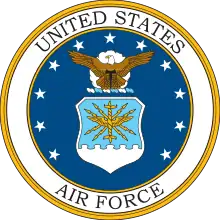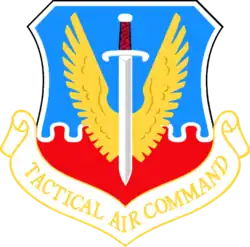430th Expeditionary Electronic Combat Squadron
The 430th Expeditionary Electronic Combat Squadron is an active United States Air Force unit. It is assigned to the 451st Expeditionary Operations Group and stationed at Kandahar Air Base, Afghanistan.
430th Expeditionary Electronic Combat Squadron
 | |
|---|---|
_67-037_with_Cannon-based_F-16_524th_TFS.jpg.webp) | |
| Active | 1943–1945; 1952–1966; 1968–1989; 1992–1993; 2013–present |
| Country | |
| Branch | |
| Role | Electronic Warfare |
| Size | Squadron |
| Part of | 451st Air Expeditionary Group |
| Garrison/HQ | Kandahar Airfield |
| Nickname(s) | WWII - The Backdoor Gang[1] Vietnam War - Tigers |
| Colors | Red |
| Mascot(s) | Tiger |
| Engagements | European Theater of Operations Korean War Vietnam War[2] Afghanistan War |
| Decorations | Distinguished Unit Citation Air Force Outstanding Unit Award with Combat "V" Device Belgian Fourragère Republic of Korea Presidential Unit Citation Republic of Vietnam Gallantry Cross with Palm[2] |
| Insignia | |
| 430th Expeditionary Electronic Combat Squadron emblem (approved 15 July 1954)[2] | 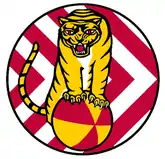 |
| 430th Fighter Squadron emblem (World War II)[3] | 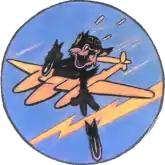 |
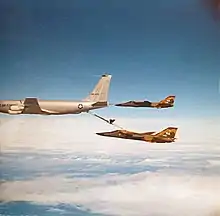

The 430th Fighter Squadron, nicknamed "The Backdoor Gang",[4] was first activated during World War II as part of the 474th Fighter Group and served in the European Theater of Operations, where it earned a Distinguished Unit Citation and the Belgian Fourragère for its actions in combat. It remained in Europe after V-E Day, returning to the United States, where it was inactivated at the Port of Embarkation in December 1945.[5]
The squadron was reactivated as the 430th Fighter-Bomber Squadron in 1952 as part og the 474th Fighter Bomber Wing and later the 474th Fighter Bomber Group, when it replaced an Air National Guard squadron in Japan. It again saw combat in the Korean War, earning another Distinguished Unit Citation and a Republic of Korea Presidential Unit Citation. The Squadron returned to the United States in 1954.
The 430th Tactical Fighter Squadron was deployed in September 1972 to Thailand to fly combat missions in the Vietnam War, and was awarded the Air Force Outstanding Unit Award with Combat "V" Device 28 Sep 1972-22 Feb 1973 and Republic of Vietnam Gallantry Cross with Palm 28 Sep 1972-22 Feb 1973. It remained a fighter unit until inactivating in 1989.
In 1992, the unit became the 430th Electronic Combat Squadron, but was only active for one year. It was converted to provisional status and received its current name in 2013.
History
World War II
The 430th Fighter Squadron was activated on 1 August 1943 as a Lockheed P-38 Lightning fighter squadron under IV Fighter Command in Southern California as part of the 474th Fighter Group. It trained with the P-38 over the Mojave Desert, moving to the European Theater of Operations, and was assigned to Ninth Air Force in England during March 1944. It operated out of Warmwell, Britain, and Saint Lambert, St. Marceau, and Peronne, France, Florennes, Belgium, and Strassfeld, Langensalza, Schweinfurt, and Stuttgart, Germany during and immediately after the war in 1945. Squadron markings on the vertical tail surfaces were a circle and "K6" with call sign "Back Door".[6][7] It provided bomber escort but the primary role was as an attack and interdiction fighter. It flew its first combat missions on 25 April 1944. As part of the 474th Fighter Group, they attacked bridges and railroads in France in preparation for the Normandy invasion, provided air cover for the invasion force, and flew bombing missions to support the landings. Subsequently it conducted armed reconnaissance missions after D-Day and attacked highways and troops to support the Allied breakthrough at St Lo. The Squadron supported the British attack on Holland in Sep 1944; the Battle of the Bulge Dec 1944-Jan 1945; and the airborne assault across the Rhine in Mar 1945. As part of the 474th, it was awarded the Distinguished Unit Citation for a mission on 23 August 1944[8] and twice the Order of the Day, Belgian Army.[9] Personnel were demobilized in Europe during 1945, returned to the United States in November as an administrative unit and was inactivated on 7 December 1945 without personnel or equipment.[10]
Cold War
Reactivated in Japan under Far East Air Forces, July 1952 as a result of the Korean War. Replaced Federalized Georgia Air National Guard personnel, receiving their Republic F-84G Thunderjets. Moved to South Korea in August as part of the 474th Fighter Bomber Wing, engaging in combat operations from Kunsan Air Base (K-8). From Kunsan the squadron bombed and strafed bridges, bunkers, troop concentrations, artillery positions, and a host of other enemy targets. Moved to Taegu Air Base (K-2) in April 1953 being attached to the 58th Fighter-Bomber Wing. Flew interdiction and close air support missions in as well as attacking special strategic targets such as military schools, dams, and port facilities in North Korea until the June 1953 Armistice, Remained in South Korea for over a year afterward to insure Communist compliance with the cease-fire.[11]
Returned to Clovis Air Force Base, New Mexico in November 1954. Squadron was re-equipped with North American F-86H Sabre fighter-bomber aircraft, being assigned to Twelfth Air Force, Tactical Air Command. Maintained proficiency in tactical fighter operations, deploying components, aircraft, and crews on a global basis in support of NATO, PACAF, AAC, and other organizations. Deployed to southeastern United States during the Cuban Missile Crisis of 1962.
Moved to Nellis Air Force Base, Nevada in 1966 as part of the 474th Tactical Fighter Wing (TFW). The 474th (Roadrunners[12]) became the first USAF operational wing equipped with the General Dynamics F-111.[13] On 20 January 1968 the 474th Tactical Fighter Wing was activated at Nellis Air Force Base, Nevada from the 4480th TFW,[14] giving the base an operational tactical fighter wing assigned to Twelfth Air Force. On 15 September 1968 the 430th TFS became part of the Wing.
Deployed to Takhli Royal Thai Air Force Base, Thailand in September 1972 as a result of the North Vietnamese Easter Offensive as part of the Constant Guard V deployment of the 429th TFS and 430th TFS with 24 F-111As in each squadron.[15] The deployment included 1,487 support personnel and 40 transport aircraft loads of cargo.[16] The enhanced strike capabilities of the two F-111 squadrons (48 aircraft) allowed them to replace the four F-4D squadrons (72 aircraft) of the 49 TFW, which returned to the U.S. This move also resulted in a reduction of total U.S. forces stationed in Thailand.[17] The two F-111A squadrons arrived to support the last month of Operation Linebacker and all of the Operation Linebacker II bombing offensive against North Vietnam, conducted combat operations in Laos including support of Operation Phou Phiang II and Operation Phou Phiang III using the F-111A's beacon bombing capability in the defense of Long Tieng, and conducted combat operations in Cambodia, again using the F-111's beacon bombing capability. They flew deep interdiction strike in good and bad weather when other squadrons were grounded. 430th TFS flew approximately 2000 combat missions with excellent success rates in hitting targets even when visibility was near zero before returning to the United States on 22 March 1973. A total of four 430th TFS aircraft were lost in action with the loss of all crews.[13] The 474th was awarded the Air Force Outstanding Unit Award with Combat "V" Device 28 Sep 1972-22 Feb 1973[18] and Republic of Vietnam Gallantry Cross with Palm 28 Sep 1972-22 Feb 1973.[19]
Engaged in training new pilots with the F-111 during the mid-1970s, changing equipment to the McDonnell F-4D Phantom II in August 1977 during "Operation Ready Switch", sending the F-111As to the 366th Tactical Fighter Wing at Mountain Home Air Force Base, Idaho and sending the F-111Fs from Mountain Home to Lakenheath Air Base in England to replace the departing F-4Ds. Received new Block 1/5 General Dynamics F-16A Fighting Falcon aircraft in November 1980 after protractive development period in the 1970s. Conducted routine Tactical Air Command training and deployments from Nellis with the F-16s, upgrading to Block 10/15 models in the early 1980s. Inactivated September 1989 when aircraft were considered no longer front-line combat capable.
Electronic combat
Reactivated at Cannon Air Force Base, New Mexico as the 430th Electronic Combat Squadron in August 1992 in conjunction with the realignment of all General Dynamics EF-111A Raven Electronic Warfare aircraft from Mountain Home to Cannon. Relieved aircraft and trained 27th Operations Group personnel in operational use. Once the move was completed the 430th was inactivated and squadron personnel and aircraft were transferred to the 429th Electronic Combat Squadron.
The squadron was reactivated as the 430th Expeditionary Electronic Combat Squadron at Kandahar Airfield, Afghanistan on 20 February 2013, when it replaced the 451st Air Expeditionary Wing's tactical airborne gateway, which had been operating since 2006.[20] The unit flies the Northrop Grumman E-11 aircraft. The mission of the E-11A is to serve as a Battlefield Airborne Communications Node, a communications system that provides voice and data connectivity across the battlespace for air and surface operators.[21]
On 27 January 2020, a United States Air Force E-11A aircraft (serial number 11–9358) belonging to 430th Expeditionary Electronic Combat Squadron crashed in Afghanistan's Dih Yak District, Ghazni Province. Two people on board were killed, the whole crew according to US military sources. The Taliban claimed to have shot the aircraft down.[22]
Lineage
- Constituted as the 430th Fighter Squadron on 26 May 1943
- Activated on 1 August 1943
- Inactivated on 7 December 1945
- Redesignated 430th Fighter-Bomber Squadron on 25 June 1952
- Activated on 10 July 1952
- Redesignated 430th Tactical Fighter Squadron on 1 July 1958
- Inactivated on 15 November 1966
- Activated on 15 September 1968
- Inactivated on 30 September 1989
- Redesignated 430th Electronic Combat Squadron and activated 1 August 1992
- Inactivated 29 June 1993
- Redesignated 430th Expeditionary Electronic Combat Squadron and converted to provisional status on 13 March 2013
- Activated 20 February 2013[2]
Assignments
- 474th Fighter Group, 1 August 1943 – 7 December 1945
- 474th Fighter-Bomber Group, 10 July 1952 (attached to 58th Fighter-Bomber Wing 1 April 1953 – 22 November 1954)
- 474th Fighter-Bomber Wing (later 474th Tactical Fighter Wing), 8 Oct 1957 – 15 November 1966
- 474th Tactical Fighter Wing, 15 September 1968 – 30 September 1989
- 27th Operations Group, 1 August 1992 – 29 June 1993
- 451st Expeditionary Operations Group, 20 February 2013
- 451st Air Expeditionary Group, 1 April 2014 – present[2]
Stations
|
|
Aircraft
|
|
Commanders
|
|
References
- Notes
- Aircraft is General Dynamics EF-111A Raven serial 67-37.
- Citations
-
- "474th Fighter Group". American Air Museum in Britain. Retrieved 5 July 2020.
- Lacomia, John M. (7 January 2018). "Factsheet 430 Expeditionary Electronic Combat Squadron (ACC)". Air Force Historical Research Agency. Retrieved 19 December 2018.
- Watkins, pp. 54–55
- "430th Fighter Squadron". American Air Museum. Retrieved 4 July 2020.
- "430 Expeditionary Electronic Combat Squadron (ACC)". Air Force Historical Research Agency. USAF. Retrieved 2 July 2020.
- "474th Fighter Group". American Air Museum in Britain. Retrieved 5 July 2020.
- "474th Fighter Group". Army Air Corps Library and Museum. Retrieved 30 June 2020.
- "474th Fighter Group". Army Air Corps Library and Museum. Retrieved 9 July 2020.
- "474th Fighter Group". American Air Museum in Britain. Retrieved 5 July 2020.
- "430 Expeditionary Electronic Combat Squadron (ACC)". Air Force Historical Research Agency. USAF. Retrieved 2 July 2020.
- "430 Expeditionary Electronic Combat Squadron (ACC)". Air Force Historical Research Agency. USAF. Retrieved 2 July 2020.
- Thornborough, Anthony M. (1989). F-111 Success in Action. London: Arms & Armour Press Ltd. p. 29. ISBN 0-85368-988-1.
- Thornborough,
- Mueller,
- Thornborough, Anthony M. and Davies, Peter E. (1989). F-111 Success in Action. London: Arms & Armour Press Ltd. p. 35. ISBN 0-85368-988-1.
- "F111s Going To Thailand". Las Vegas Review Journal. 26 September 1972.
- "F111s Going To Thailand". Las Vegas Review Journal. 26 September 1972.
- Jones (30 June 1976). "Air Force Outstanding Unit Award (with Combat V Device)". Special Order GB-489: 1.
- Jones (1977). "Award of the Republic of Vietnam Galantry Cross with Palm". Special Order GB-322: 1.
- Hinderliter, Capt Tristan (15 March 2013). "Same mission, new name for E-11A unit at Kandahar Airfield". 451st Air Expeditionary Wing Public Affairs. Retrieved 3 July 2017.
- Welsh, Patty (2 February 2016). "Comms program hits 100,000 hours of warfighter connectivity". United States Air Public Affairs. Retrieved 3 July 2017.
- Afghan plane crash: US jet comes down in Taliban territory
- "430 Expeditionary Electronic Combat Squadron (ACC)". Air Force Historical Research Agency. USAF. Retrieved 2 July 2020.
- "430 Expeditionary Electronic Combat Squadron (ACC)". Air Force Historical Research Agency. USAF. Retrieved 2 July 2020.
- Station number in Anderson.
- Station number in Johnson.
- "430 Expeditionary Electronic Combat Squadron (ACC)". Air Force Historical Research Agency. USAF. Retrieved 2 July 2020.
- "430 Expeditionary Electronic Combat Squadron (ACC)". Air Force Historical Research Agency. USAF. Retrieved 2 July 2020.
Bibliography
![]() This article incorporates public domain material from the Air Force Historical Research Agency website http://www.afhra.af.mil/.
This article incorporates public domain material from the Air Force Historical Research Agency website http://www.afhra.af.mil/.
- "430 Expeditionary Electronic Combat Squadron (ACC)". Air Force Historical Research Agency. USAF. Retrieved 2 July 2020.
- "474th Fighter Group". American Air Museum in Britain. Retrieved 5 July 2020.
- "474th Fighter Bomber Group". Korean War Project. Retrieved 29 June 2020.
- "474th Fighter Bomber Wing". KoreanWar.org. Retrieved 19 June 2020.
- "F111s Going To Thailand". Las Vegas Review Journal. 26 September 1972.
- Anderson, Capt. Barry (1985). Army Air Forces Stations: A Guide to the Stations Where U.S. Army Air Forces Personnel Served in the United Kingdom During World War II (PDF). Maxwell AFB, AL yes: Research Division, USAF Historical Research Center. Archived from the original (PDF) on 23 January 2016. Retrieved 28 June 2017.
- Anthony, Victor B.; Sexton, Richard R. (1993). "The War In Northern Laos 1958-1973". The United States Air Force In Southeast Asia. DTIC ADA512223. Washington D.C.: Center for Air Force History. UNCLASSIFIED.
- Ballard, Jack S. (1984). "1961-1973: An Illustrated Account". The United States Air Force In Southeast Asia. DTIC ADA160932. Washington D.C.: Center for Air Force History. UNCLASSIFIED.
- Davies, Peter (2013). General Dynamics F-111 Aardvark. Great Britain: Osprey Publishing Ltd. ISBN 978-1-78096-611-3.
- Davies, Peter E.; Thornborough, Anthony M. (1997). F-111 Aardvark. Ramsbury, Marlborough Wiltshire. UK: The Crowood Press Ltd. ISBN 1-86126-079-2.
- Defense POW/MIA Accounting Agency, (PMSEA) (24 April 2020). "Report for Air Force". Accounted For - Identified Since 1973.
- Drendel, Lou (1978). F-111 in Action. Warren, MI, USA: Squadron/Signal Publications, Inc. ISBN 0-89747-083-4.
- Elder, Major (15 April 1974). "Air Operations In The Khmer Republic 1 Dec 1971 - 15 Aug 1973". CHECO/CORONA HARVEST Division, DCS/Plans and Operations, HQ PACAF. DTIC ADB355566. Hq USAF: Department of the Air Force. Project CHECO Report (Special Project). UNCLASSIFIED.
- Futrell, Robert F. (1983). The United States Air Forces in Korea 1950–1953 (PDF). Washington, DC: Office of Air Force History. ISBN 0-912799-71-4. Retrieved 17 December 2016.
- Gunston, Bill. F-111. New York: Charles Scribner's Sons, 1978. ISBN 0-684-15753-5.
- Gunston, Bill. F-111, (Modern Fighting Aircraft, Vol. 3). New York: Salamander Books, 1983. ISBN 0-668-05904-4.
- Holland, Thomas D. PhD (12 December 2011). "Identification of CIL 1995-030-I-01". Joint POW/MIA Accounting Command. Memorandum For The Record.
- Johnson, 1st Lt. David C. (1988). U.S. Army Air Forces Continental Airfields (ETO) D-Day to V-E Day (PDF). Maxwell AFB, AL: Research Division, USAF Historical Research Center. Archived from the original (PDF) on 29 September 2015. Retrieved 26 June 2017.
- Jones, David C. USAF Chief of Staff (30 June 1976). "Air Force Outstanding Unit Award (with Combat V Device)". Special Order GB-489.
- Jones, David C. USAF Chief of Staff (25 April 1977). "Award of the Republic of Vietnam Galantry Cross with Palm". Special Order GB-322.
- Martin, Patrick (1994). Tail Code: The Complete History of USAF Tactical Aircraft Tail Code Markings. Atglen, PA: Schiffer Military Aviation History. ISBN 0-88740-513-4.
- Maurer, Maurer, ed. (1983) [1961]. Air Force Combat Units of World War II (PDF) (reprint ed.). Washington, DC: Office of Air Force History. ISBN 0-912799-02-1. LCCN 61060979. Retrieved 17 December 2016.
- Maurer, Maurer, ed. (1982) [1969]. Combat Squadrons of the Air Force, World War II (PDF) (reprint ed.). Washington, DC: Office of Air Force History. ISBN 0-405-12194-6. LCCN 70605402. OCLC 72556. Retrieved 17 December 2016.
- Mueller, Robert (1989). Air Force Bases, Vol. I, Active Air Force Bases Within the United States of America on 17 September 1982 (PDF). Washington, DC: Office of Air Force History. ISBN 0-912799-53-6. Retrieved 17 December 2016.
- Picinich, A.A., Colonel (21 February 1974). Radzykewycz, D.T., Captain (ed.). "The F-111 In Southeast Asia September 1972 - January 1973". CHECO/CORONA HARVEST Division, DCS/Plans and Operations, HQ PACAF. DTIC ADC007778. Hq USAF: Department of the Air Force. Project CHECO Report (Special Project). UNCLASSIFIED.
- Ravenstein, Charles A. (1984). Air Force Combat Wings, Lineage & Honors Histories 1947–1977. Washington, DC: Office of Air Force History. ISBN 0-912799-12-9. Retrieved 17 December 2016.
- Rogers, Brian. (2005). United States Air Force Unit Designations Since 1978. Hinkley, UK: Midland Publications. ISBN 1-85780-197-0.
- Schlight, Josh (1996). "A War Too Long". The United States Air Force In Southeast Asia 1961-1975. DTIC ADA440394. Washington D.C.: Center for Air Force History. UNCLASSIFIED.
- Sine, Rick. "474th TFW Reunion". f111reunion.
- Thornborough, Anthony M. and Davies, Peter E. (1989). F-111 Success in Action. London: Arms & Armour Press Ltd. ISBN 0-85368-988-1.
- Thornborough, Tony (1993). F-111 Aardvark: USAF's Ultimate Strike Aircraft. Osprey Military Aircraft. Oxford, UK: Osprey Publishing. ISBN 1-85532-259-5.
- Watkins, Robert (2008). Battle Colors. Vol III Insignia and Markings of the Ninth Air Force in World War II. Atglen, PA: Shiffer Publishing Ltd. ISBN 978-0-7643-2938-8.
